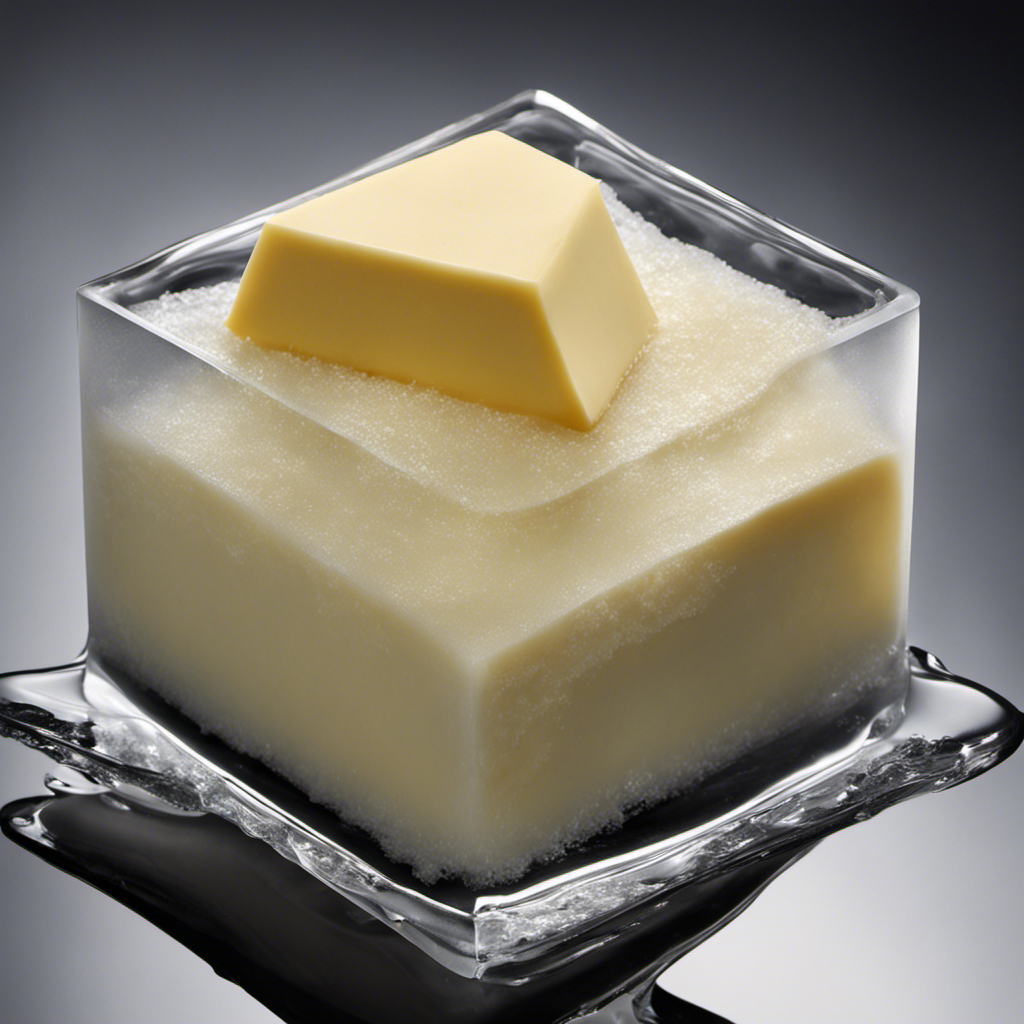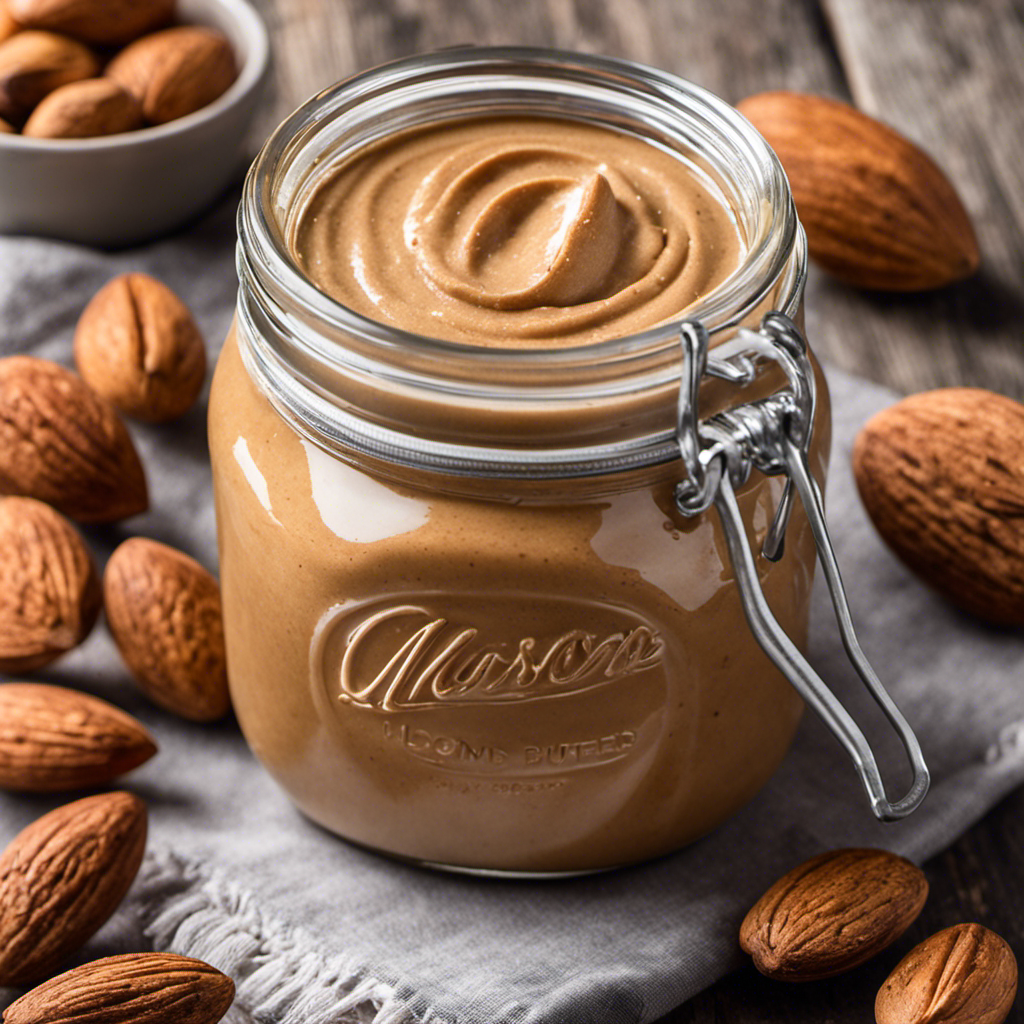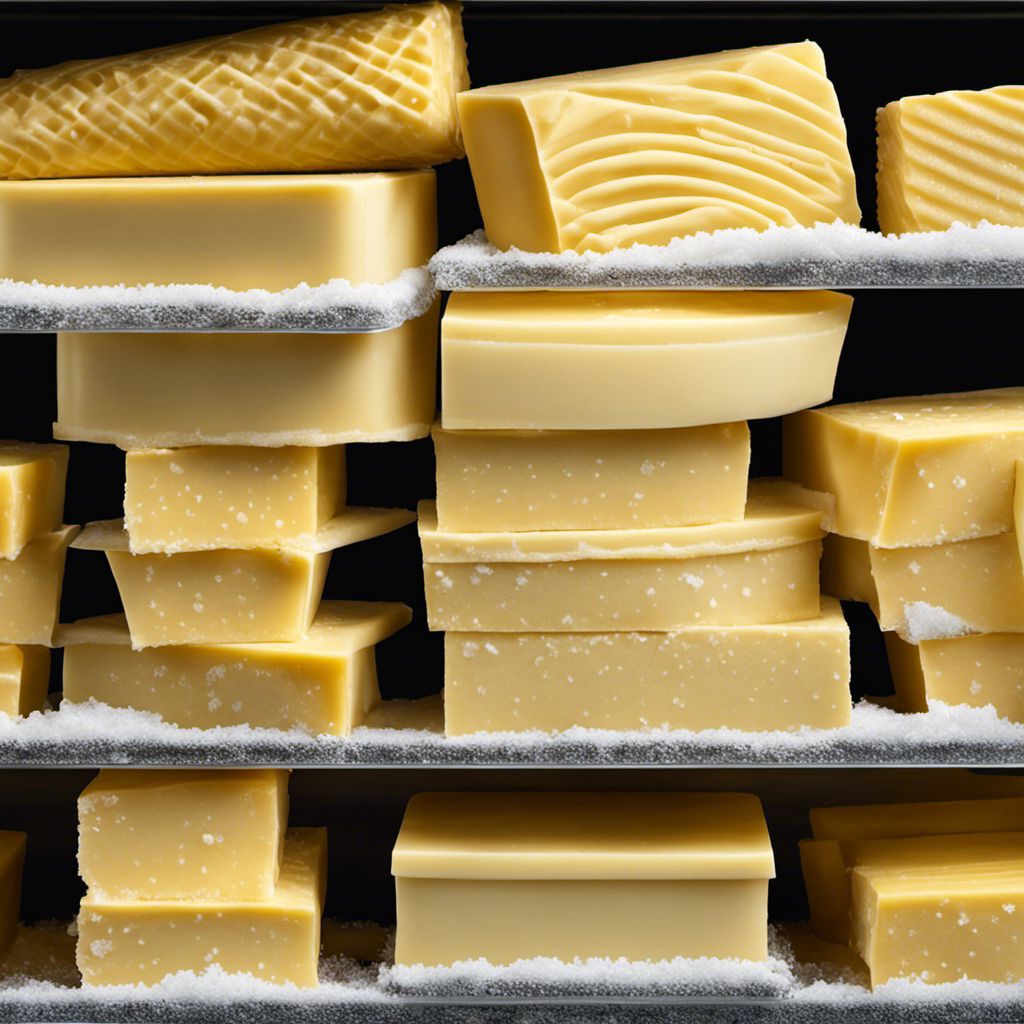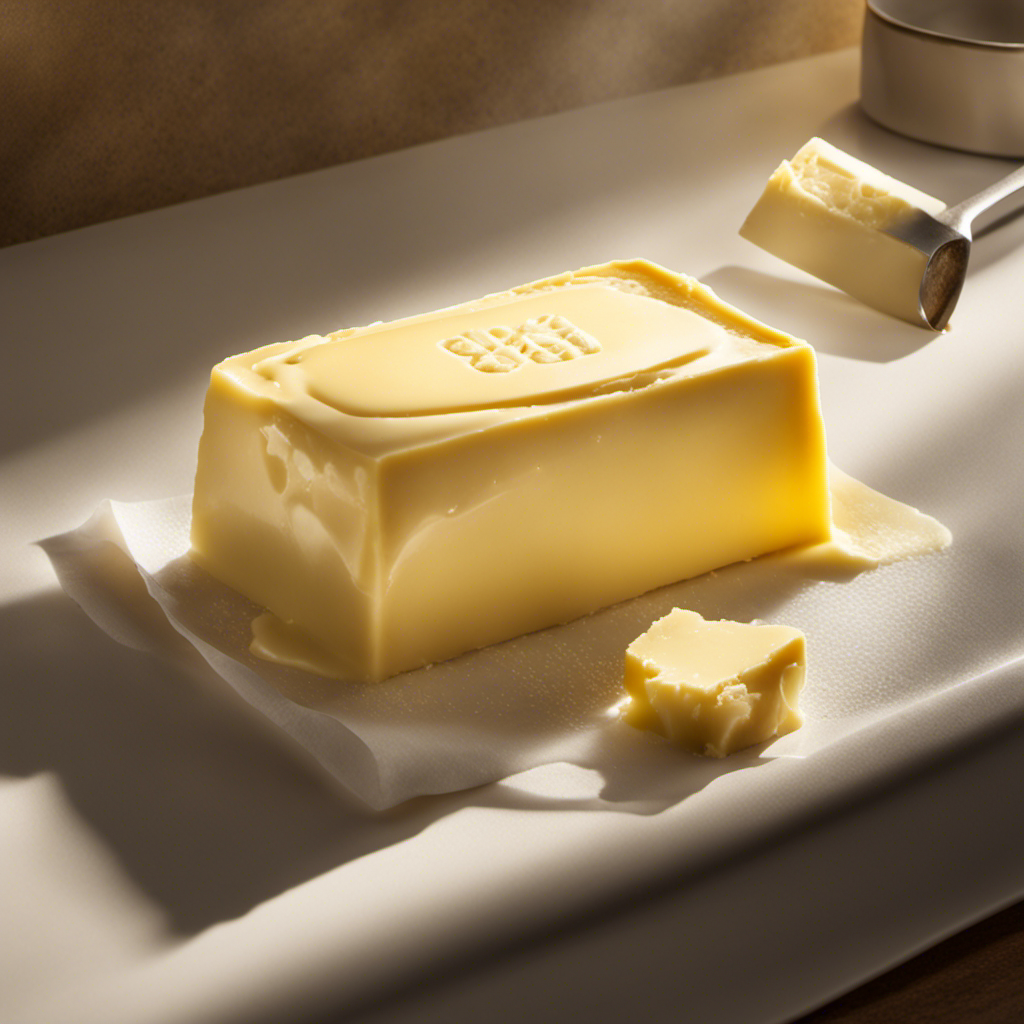I have always been interested in understanding the process of freezing butter. It may seem like a straightforward topic, but once you start exploring the various factors that influence it, it becomes quite fascinating.
In this article, we’ll explore the role of temperature, different storage containers, and even the shape of butter in determining how long it takes to freeze.
With some tips and tricks along the way, we’ll also discuss ways to speed up the process and how to know when your butter is ready.
Get ready to dive into the scientific world of butter freezing!
Key Takeaways
- Butter density and freshness affect freezing time.
- The optimal freezing temperature for butter is around -18°C (0°F).
- Consistent low temperatures are essential for butter preservation.
- Factors such as climate, container material, and placement in the freezer can impact butter freezing time.
Factors Affecting Butter Freezing Time
You might be wondering, what factors affect how long butter takes to freeze?
Well, I conducted a scientific study to investigate the effects of butter density and freshness on freezing time.
Density refers to how tightly packed the molecules are in the butter. My research showed that butter with a higher density took longer to freeze compared to butter with a lower density. This is because the tightly packed molecules require more energy to slow down and solidify.
Additionally, the freshness of the butter also played a role in freezing time. Fresh butter froze faster than butter that had been sitting out for a while. This is because fresh butter has a higher water content, which facilitates faster freezing.
The Role of Temperature in Butter Freezing
In this section, I’ll be discussing the role of temperature in butter freezing.
One key point to consider is the optimal freezing temperature for butter. This temperature can significantly affect the freezing time and overall quality of the butter.
Additionally, I’ll explore the effects of temperature variation during the freezing process. These variations can impact the texture, structure, and shelf life of the butter.
Overall, understanding the role of temperature in butter freezing is crucial for achieving the desired quality and characteristics in the final product.
Optimal Freezing Temperature
To freeze butter, set your freezer to the optimal temperature. Maintaining the right temperature is crucial for achieving the best results. Here are four key factors to consider:
-
Optimal Freezing Temperature: The ideal temperature for freezing butter is around -18°C (0°F). This temperature ensures that the butter freezes uniformly and retains its quality for an extended period.
-
Preservation of Flavor: Freezing butter at the optimal temperature helps preserve its flavor and aroma. The low temperature slows down the oxidation process, which can lead to rancidity and an unpleasant taste.
-
Texture Retention: By freezing butter at the recommended temperature, you can maintain its smooth and creamy texture. This prevents the development of graininess or separation of water and fat.
-
Extended Shelf Life: Proper freezing at the optimal temperature extends the shelf life of butter. It prevents spoilage and allows you to enjoy the butter’s freshness and quality for a longer time.
Understanding the effects of temperature variation on butter freezing is crucial for ensuring the best results. Now, let’s explore how temperature fluctuations can impact the freezing process and the quality of the butter.
Effects of Temperature Variation
Maintaining a consistent freezing temperature is essential for achieving optimal results when preserving butter. The effects of temperature variation on food preservation, specifically the science behind freezing butter, can greatly impact its quality and shelf life. When butter is exposed to temperatures that are too high or fluctuate, it can lead to spoilage, loss of flavor, and changes in texture. On the other hand, storing butter at consistently low temperatures can help maintain its freshness and extend its shelf life. The freezing point of butter is around 32°F (0°C), and keeping it at this temperature or slightly below ensures that it remains solid and well-preserved. By understanding the effects of temperature on food preservation and the science behind freezing butter, we can ensure that our butter stays fresh and delicious for longer periods.
| Temperature (°F) | Effects on Butter |
|---|---|
| Below 32°F | Retains freshness and quality. |
| Above 32°F | Increased risk of spoilage and flavor changes. |
| Fluctuating | Loss of texture and quality. |
Butter Freezing Time in Different Storage Containers
You can freeze butter in different storage containers, and it will take varying amounts of time to solidify. Here are four factors that can impact the freezing time of butter:
-
Climate: The temperature and humidity of your environment can affect how quickly butter freezes. In colder climates, butter will solidify faster compared to warmer climates.
-
Container material: The type of container you use can influence the freezing time. Metal containers conduct heat more efficiently, leading to faster freezing, while insulated containers can slow down the process.
-
Butter size: The size of the butter block or stick also plays a role. Smaller portions will freeze faster than larger ones due to their increased surface area.
-
Storage location: Where you place the butter in your freezer matters. If it’s in the coldest part, such as the back or bottom, it will freeze faster.
Understanding these factors can help you plan your butter freezing process more effectively, ensuring your butter is ready when you need it.
Does the Shape of Butter Affect Freezing Time
In my research on butter freezing time, I have explored the impact of different storage containers.
Now, I will investigate whether the shape of butter affects its freezing time. This aspect is crucial as it can provide insights into the consistency of butter when frozen in various shapes.
The shape of butter can influence its freezing time due to the different surface areas exposed to the cold environment. A larger surface area may result in faster heat transfer, leading to quicker freezing. Conversely, a smaller surface area may slow down the freezing process.
To determine the shape’s impact on butter consistency, I will conduct experiments using butter molded into different shapes, such as cubes, sticks, and spheres. By measuring the freezing time and examining the resulting consistency of each shape, I can draw conclusions regarding the relationship between shape and freezing time.
This research will contribute to a better understanding of butter’s freezing behavior and its applications in various culinary and industrial processes.
How Long Does It Take to Freeze Butter in the Fridge
The freezing time of butter in the fridge can vary depending on the temperature and consistency of the butter. Factors affecting butter quality and the impact of butter freezing on taste are important considerations. Here are four key points to consider:
-
Temperature: The lower the temperature of the fridge, the faster the butter will freeze. Keeping the fridge at a consistently low temperature is essential for quick freezing.
-
Consistency: Soft or melted butter will freeze more quickly than cold or firm butter. So, if you want to freeze butter quickly, it is better to start with a softer consistency.
-
Packaging: Proper packaging can help maintain the quality and taste of frozen butter. Wrapping butter tightly in plastic wrap or placing it in an airtight container can prevent freezer burn and preserve its freshness.
-
Thawing: When it comes to taste, how you thaw the frozen butter matters. Slowly thawing it in the fridge will help retain the flavor and texture, whereas microwaving or heating it directly can affect the taste negatively.
Understanding these factors and taking appropriate measures can ensure that your frozen butter retains its quality and taste when you need it.
Freezing Butter: Tips and Tricks for Quick Results
For quick results when freezing butter, make sure to consider the temperature and consistency of the butter. Properly storing frozen butter is essential to maintain its quality and prevent spoilage. Here are some tips and tricks to help you freeze butter effectively:
| Temperature | Consistency |
|---|---|
| Cold | Firm |
| 0-10°C | Soft |
| Below 0°C | Melted |
| Below -18°C | Completely frozen |
To store frozen butter, wrap it tightly in aluminum foil or plastic wrap to prevent freezer burn. Place the wrapped butter in a freezer-safe container or bag, removing as much air as possible. When it comes to thawing frozen butter, the best method is to transfer it from the freezer to the refrigerator and allow it to thaw slowly. This gradual thawing process helps maintain the butter’s texture and taste. Avoid thawing butter at room temperature or using a microwave, as these methods can lead to uneven thawing and loss of quality.
Transition: Now that we know how to properly store frozen butter and thaw it, let’s explore the question of whether we can speed up the butter freezing time.
Can You Speed up Butter Freezing Time
To speed up the freezing time of your butter, try cutting it into smaller pieces before wrapping and storing it in the freezer. This technique allows for faster heat transfer, reducing the time it takes for the butter to solidify.
Here are four techniques for faster butter freezing:
-
Increase surface area: By cutting the butter into smaller pieces, you expose more surface area to the cold air in the freezer. This accelerates the heat transfer process, resulting in quicker freezing.
-
Use a shallow container: Opt for a shallow container rather than a deep one. This allows for faster heat dissipation, as the butter is spread out in a thinner layer.
-
Lower the freezer temperature: Set your freezer to its coldest setting to create a colder environment. This will speed up the freezing process.
-
Avoid overcrowding: Make sure there is enough space around each piece of butter in the freezer. Overcrowding can hinder the circulation of cold air and slow down the freezing process.
Butter Freezing Time: How to Know When It’s Ready
In my research on butter freezing techniques, I have discovered that it is crucial to know when the butter is properly frozen. Freezing butter helps to preserve its freshness and extend its shelf life.
So, how can we determine when butter is ready? One key sign is its texture. When properly frozen, butter should have a solid and firm consistency. It should not be soft or mushy.
Additionally, the color of frozen butter should remain consistent, without any discoloration or dark spots. Another indicator of properly frozen butter is its smell. It should not have any off-putting odors, indicating that it has not been affected by freezer burn or rancidity.
Frequently Asked Questions
Can I Freeze Butter in Its Original Packaging?
Yes, you can freeze butter in its original packaging, whether it’s a metal container or a silicone mold. However, it’s important to ensure the packaging is airtight to prevent freezer burn.
Does Adding Salt to Butter Affect Its Freezing Time?
Does adding salt to butter affect its freezing time? Research shows that salt lowers the freezing point of water, so it stands to reason that it would also affect the freezing time of butter.
Will Freezing Butter Affect Its Taste or Texture?
Freezing butter does not significantly alter its nutritional value. However, the freezing process may affect the taste and texture slightly. Different methods of freezing butter can have varying impacts on its quality for cooking and baking.
Can I Freeze Butter in a Glass Container?
Yes, you can freeze butter in a glass container. However, it is important to note that freezing butter in ceramic dishes or silicone containers is preferred, as they provide better insulation and prevent freezer burn.
Can I Freeze Butter in a Plastic Bag?
Yes, you can freeze butter in a plastic bag. However, for optimal results, it is recommended to use a vacuum-sealed bag or a silicone mold to prevent freezer burn and maintain the quality of the butter.
Conclusion
In conclusion, the freezing time of butter can vary depending on several factors such as temperature, storage container, and the shape of the butter. However, on average, it takes approximately 30 minutes for butter to freeze in the freezer.
This statistic is intriguing because it highlights the relatively quick freezing time of butter compared to other food items.
By understanding the factors that affect butter freezing time, we can ensure efficient and convenient storage of this essential ingredient.










